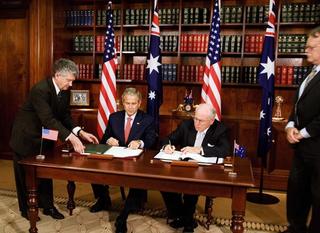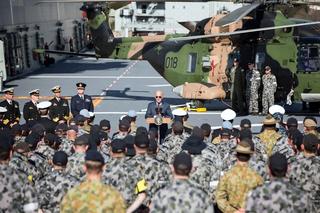Executive summary
- The United States’ National Technology and Industrial Base (NTIB) is a congressionally mandated policy framework intended to foster integration and collaboration between defence companies and authorities based in the United States, Canada, Australia, the United Kingdom and New Zealand.
- Though often overshadowed by the AUKUS partnership, it was Australia’s addition to the NTIB in 2017 that provided it with much of the legal, policy and regulatory scaffolding required to more closely integrate with the United States’ defence industrial base (DIB) and, by extension, with those of other Five Eyes Partners. The objectives of the two initiatives are mutually reinforcing: while AUKUS has imparted much-needed political impetus onto the integration agenda, the NTIB provides the functional means to realise it.
- Yet even with AUKUS and the NTIB in place, the promise of greater Australian access and contribution to the US DIB remains largely unrealised. A combination of bureaucratic inertia, lack of high-level government support, bit-part legislative reforms, and steep compliance costs for Australian businesses has effectively put the NTIB on ice since the turn of the decade. AUKUS now faces many of the same challenges, yet it lacks several of the disciplining functions that the NTIB could, with sufficient attention and resources, provide.
- Encouragingly, recent AUKUS-inspired developments — especially defence trade control reforms — have revived interest in some quarters in revitalising the NTIB as a mechanism for driving defence industrial integration. Doing so will require recasting the NTIB narrative in terms reflective of new political and strategic realities in member states; sustained senior-level attention; institutionalising coordination mechanisms to harmonise members’ DIBs; targeted regulatory reforms and acquisition policy innovation; and cultural changes within the defence establishments of member states that prioritise speed to capability.
Recommendations
- Reset the narrative: the Trump administration is eager to dismantle atrophied institutions in favour of nimble, cross-sector solutions, a position widely held by all NTIB members. Australian policymakers should seek to recast the NTIB as a means to revitalise the collective DIB, not simply to embed existing practices and institutions.
- Furthering harmonisation efforts: building on AUKUS-driven efforts to harmonise defence trade controls between NTIB member states, Canberra and Washington should seek to revive NTIB mechanisms, including focussed working groups on industrial security issues — intended to facilitate senior-level discussions on aligning other defence industrial policy and regulatory instruments.
- Lessons from NASA: NTIB partners should seek to emulate the contracting and acquisition conditions that led to breakthroughs in cost-effective rocket and satellite production/acquisition in partnership with the private sector.
- Culture and mindset: in addition to creating the functional means for accelerated innovation, NTIB partners should foster defence acquisition, development procurement cultures that borrow from commercial best practices, including prioritising rapid adaptation and expansion over risk-averse business practices.
Introduction
While AUKUS dominates strategic discourse with its nuclear-powered submarines and advanced capability promises, the often-overlooked National Technology and Industrial Base (NTIB) remains the legal and institutional foundation underpinning allied defence integration between Australia and the United States, along with Canada and the United Kingdom. Yet despite offering Australia privileged status as a part of the legal definition of the US industrial base,1 the NTIB’s implementation since 2017 has faltered. For Australia, NTIB access remains opaque, underused and mired in bureaucratic inertia with particularly acute consequences for Australian small to medium enterprises (SMEs), many of which face steep compliance costs, licensing delays and ambiguous eligibility.
Recent wins, such as defence trade control reforms and cross-border prototype contracts, have demonstrated what is possible when policy ambition aligns with operational follow-through.
Nevertheless, the NTIB’s structural promise remains intact. Lessons from AUKUS — particularly its Pillar II focus on advanced capabilities — have reawakened interest in some quarters in reviving the NTIB’s dormant potential. Recent wins, such as defence trade control reforms and cross-border prototype contracts, have demonstrated what is possible when policy ambition aligns with operational follow-through. Yet these remain boutique exceptions rather than systemic norms. To avoid another cycle of crisis-driven improvisation, Australia and its partners must reframe NTIB reforms in terms that are reflective of the new political and strategic realities in all member countries: industrial resilience, accelerated innovation and economic security. Revitalising the NTIB requires political courage, cross-sector trust and cultural change. If allies fail to act, the next strategic shock will not just test their resolve — it will expose the consequences of leaving the NTIB as an idea rather than a functioning instrument of collective security. As a guiding ethos, future NTIB reform should borrow lessons from NASA’s commercial space transformation — where regulatory agility, milestone-driven funding and cross-border cooperation unlocked rapid capability delivery.
AUKUS grabs the headlines — NTIB provides the scaffolding
When Australia (along with the United Kingdom) was added to the legal definition of the US NTIB in 2017, defence officials promised a “seamless allied marketplace” linking factories in Adelaide, Barrow-in-Furness, Montréal and Connecticut.2 Yet even with the addition of New Zealand in 2023, rounding out the ‘Five Eyes’ membership of the NTIB, this mechanism has notably faded from view as a viable means of industrial integration.3 Indeed, the NTIB has become overshadowed by the AUKUS partnership, announced in 2021, whose high-profile submarine program and commitments to advanced technology development dominate policy discourse and action.

The contrast is deceptive, tempting some to dismiss the NTIB as AUKUS’ poor cousin. Yet this is a false comparison. Not only does the NTIB predate AUKUS, it serves a fundamentally different purpose: to integrate the industrial capacities of all Five Eyes partners under a US-centric legal architecture.4 It aims to align supply chains, export controls and research protocols so that, in both peace and crisis, allied readiness draws seamlessly on a shared defence-wide ecosystem, rather than the limited subset of capabilities that AUKUS focuses on. Yet it is that very breadth that has perhaps proven problematic for the NTIB — an expansive framework that, while essential, lacks the urgency and narrative clarity needed to galvanise political will behind difficult reform, or capture public attention in a way in which AUKUS, by comparison, has proven relatively successful.5
The NTIB’s implementation, however, provides critical lessons. In the wake of the AUKUS announcement in 2021, Australian policymakers and diplomats quickly learned that a better understanding of the NTIB and reflection upon the lessons learned from its bit-part implementation would be essential to identifying and addressing key friction points in the service of operationalising AUKUS. It was quickly understood that the NTIB provides the legal and institutional scaffolding that will ultimately allow AUKUS — particularly Pillar II (Advanced Capabilities) — to function as intended. In other words, AUKUS leverages the trust architecture and institutional scaffolding that the expanded NTIB codified years earlier.
In the wake of the AUKUS announcement in 2021, Australian policymakers and diplomats quickly learned that a better understanding of the NTIB and reflection upon the lessons learned from its bit-part implementation would be essential to identifying and addressing key friction points in the service of operationalising AUKUS.
Yet despite that evident synergy, the NTIB remains underused even as AUKUS seeks to achieve many identical defence industrial and technology integration goals. A renewed sense of political and institutional urgency is needed to revive its latent potential and to offset the stalling effect of political cycles in member countries, with the associated risk of reinventing the wheel. By pairing the NTIB’s legal scaffolding with AUKUS’s high-profile momentum and borrowing rapid procurement and cross-border frameworks from heavily legislated adjacent sectors, policymakers in Australia and the United States could yet galvanise sustained, broad-based allied industrial integration rather than through episodic, narrow and cycle-driven initiatives.
A long courtship: From wartime expediency to statute
Industrial collaboration between Australia and the United States predates the NTIB. During the Second World War, Australian yards refitted US cruisers damaged in the Coral Sea.6 Cooperation hardened into the 1951 ANZUS Treaty and eventually into joint intelligence and wider defence industrial arrangements. By the 1980s, for example, Australian firms were supplying components for the F-111 strike aircraft.7 Yet the architecture for such collaboration remained ad hoc until 1993, when Congress cited a Gulf-war licensing controversy over 155 mm Canadian artillery rounds as a vivid example of where and why defence trade rules needed to change, to ensure that wartime access to all critical defence articles would never again be blocked by export paperwork.8 The NTIB initially justified a much broader North American integration agenda until the 2017 National Defense Authorization Act added the United Kingdom and Australia, followed by New Zealand in 2023.9
Canberra signs on: Expectations and early enthusiasm
For Australia, its addition to the NTIB in 2017 rested on four interlocking motives, each reflecting a distinct strand of Australia’s strategic calculus.
Firstly, membership to the NTIB offered another means to push for greater integration with the US industrial base after the stalled 2007 Australia-US Defence Trade Cooperation Treaty (DTCT).10 Despite its early promise, the DTCT never produced the true Canadian-style ‘open gate’ — that is, a widely license-free defence trade environment between the United States and a given ally — that it was intended to for Australia. After six years of congressional wrangling over oversight prerogatives, the treaty finally entered into force in 2012 to muted political applause.11 By then, its chief originators — US President George W. Bush and Australian Prime Minister John Howard — had departed office, and both governments had shifted their attention to more urgent matters elsewhere. Official implementing documents, including a 2015 Australian Department of Defence review, show that the scope of the DTCT was limited by a sweeping exclusion list and onerous compliance machinery, meaning that most eligible Australian firms had seen no real speed or certainty benefit and continued to rely on seeking onerous but familiar one-off International Traffic in Arms Regulations (ITAR) licences.12 As it was, neither Washington nor Canberra invested in the sustained diplomatic or bureaucratic effort needed to overcome the shortcomings of this limited bilateral, pre-approved 'licence-free' community — that is, until Australia’s addition to the NTIB.

Secondly, securing NTIB membership represented a visible and institutional deepening of Australia’s strategic bond with the United States. In many ways, industrial integration through the NTIB represented the final pillar of Australia’s long-standing defence partnership with the United States, complementing Australia’s membership in the Five Eyes intelligence alliance, its high levels of military interoperability, and decades of close strategic coordination. What remained was the ability to translate this strategic thrust into industrial outcomes. As such, the NTIB expansion was supposed to enable Australian firms to engage directly in allied technology development, access sensitive supply chains and co-produce next-generation defence capabilities, thereby closing the alliance integration gap.
A decade on from the signing of the DTCT, embedding Australia’s defence industry more firmly within US law did more than signal commitment — it codified it. By institutionalising interoperability at the industrial level, the arrangement was intended to support seamless integration commensurate with the close operational and intelligence relationship between Australian and US forces, ensuring that allied forces not only fight together but would also share access to a unified supply chain and shared capabilities.13
In many ways, industrial integration through the NTIB represented the final pillar of Australia’s long-standing defence partnership with the United States.
Thirdly, the NTIB held out the prospect of significant market expansion to Australia’s relatively small industrial base, including through promises of access to Pentagon contracts and industrial-base grants. It would ostensibly open to Australian firms the prospect of selling to the much-coveted US defence market, including in electronic warfare, advanced propulsion and precision munitions — all areas where Australian firms had demonstrated world-class capabilities.14 It also hinted at opportunities to bypass onerous licensing regimes under the ITAR and to compete for US research and development funding under Defense Production Act Title III and through the Defense Innovation Unit.15 The Australian Government hoped these pathways would catalyse greater domestic innovation, attract global capital and support a long-term pipeline for Australian dual-use technology development.16
Finally, the Australian Government also sought to leverage NTIB membership in the interests of sovereignty through integration. The idea that sovereignty could be safeguarded by embedding deeper into another country’s legal and supply-chain frameworks was counterintuitive yet compelling. This was reflective of the reality that, for Australia, securing access to the industrial capabilities required to underwrite a credible sovereign defence posture would ultimately require strong and deep international partnerships. For example, Australia’s ambitious national naval recapitalisation enterprise, set out in the 2017 National Naval Shipbuilding Plan, depended on collaboration with global partners.17 Even so, policymakers still feared that, in a crisis, foreign suppliers might be compelled by their governments to halt deliveries of weapons, parts or critical subcomponents if their own means could not be met or if political prerogatives changed.18
Reality bites: An incomplete implementation
In the early days of the NTIB, hopes for integration were sky-high with seminars promising license-free transfers under ITAR §126.16,19 while universities and industry envisioned shared laboratories that would allow sensitive technologies to move seamlessly between the United States and Australia and enable joint testing of cutting-edge capabilities.20 In reality, sailing has been far from smooth. For instance, the nature of NTIB compliance requirements concerning regulations like export controls has imposed steep and often underestimated costs on Australian companies — especially small to medium enterprises (SMEs), which make up over 80% of Australia’s defence industrial base.21 For years, many Australian SMEs invested in joint projects with US primes, assuming ITAR exemptions or accelerated approvals. Instead, ITAR restrictions largely remained intact, with no special mechanisms to operationalise Australia’s NTIB status until exemptions were passed to facilitate AUKUS projects in late 2024.22 Lacking in-house compliance capabilities, many SMEs have faced duplicative export burdens, costly legal reviews and delays that have forced some to abandon US partnerships entirely or have deterred others from engaging in such ventures in the first place.23
Another complicating factor is that the NTIB does not include one sweeping ‘buy Australian’ exemption clause. Instead, Congress sprinkled eligibility clauses for more than 100 item-specific sourcing laws throughout the legislation — one for bearings, another for naval pumps, another for bus chassis, and so on.24 Each statute uses its own verbs (“may waive,” “shall treat as domestic”), and only some mention the NTIB. Faced with that legal mosaic, Pentagon contracting officers have often defaulted to caution: unless a solicitation cites an item whose text unmistakably extends to NTIB members, they have regularly labelled Australian products as ‘foreign’ despite the country’s status as a domestic source under US law.25 The US Government Accountability Office’s 2024 audit of 65 Navy case files shows waivers applied to just 18% of tender opportunities, largely because “legal coverage [of foreign sources] was ambiguous.”26 In practical terms, Australian firms have thus gained only partial access to the US defence market despite the mechanisms and legislation required to do so largely being in place.
Drag leads to the confidence gap
Australia continues to face disproportionately high licensing burdens compared to other close allies. According to the US Commerce Department, recent reforms are expected to eliminate over 1,800 licence requirements annually for Australian and UK exporters — a burden Canada has not faced since being granted a broad license exemption under US law. Prior to these changes, fewer than 5% of dual-use exports from Australia qualified for licence-free treatment, compared with approximately 57% for Canada and 22% for the UK.27 The drag is visible in case studies:
- Electro Optic Systems (EOS): In 2023, Canberra-based EOS attempted to ship laser-guided 30mm ammunition prototypes to an Arizona test range. ITAR classified the rounds as “Significant Military Equipment,” adding a 90-day congressional-notification clock. The result was that the test slipped a costly six months, and EOS decided to shift its research and development (R&D) to Texas under a domestic joint venture so its rounds could move within US territory licence-free.28
- Austal Ltd.: Perth-based shipbuilder supplied modules for the US Navy’s Littoral Combat Ship (LCS). Because Austal USA is legally a separate “foreign-owned entity,” classified drawings needed to transit through a proxy server in Mobile, Alabama, where US nationals stripped metadata before forwarding files to Australia — a workaround that added costs and schedule risk to the joint project.29
- Saber Astronautics: This Sydney start-up delivered space-traffic-management software to US Space Command. Source code updates needed to be routed through an ITAR Technical Assistance Agreement (TAA), which took 11 months to negotiate. As a result, the firm now runs two code bases — one US, one Australian — raising cyber-patching and data efficiency headaches.30
It is perhaps unsurprising that many Australian SMEs, many of which derive most of their revenue from mining or civil aerospace, often see the NTIB as a paperwork trap. A 2024 Industry Capability Network survey of 112 firms found that:
- 61% of companies surveyed could not explain what Australia’s NTIB status does for their business.
- 43% believed that the NTIB has been superseded by AUKUS.
- Only 9% had sought a US contract invoking NTIB privileges.31
These perceptions compound with the delays, opaque rules and costly workarounds already experienced by Australian SMEs, most of which neither understand the NTIB’s prospective benefits nor leverage its privileges.
Canberra’s unfulfilled promise: A story of drift, not malice
For Australia, joining the NTIB in 2017 should have been a watershed: privileged access to and status within the US defence industrial base, relief from red tape and a legally codified allied supply chain.32 Yet the promise has gone largely unfulfilled, due to policy inertia more than something intentional, despite significant attention being paid to the NTIB in recent Australian strategic documents. Australia’s 2023 Defence Strategic Review suggested that the Australian Department of Defence treat access to the US NTIB more as a military readiness metric,33 but if and how this was implemented remains unclear, despite the many NTIB references made in subsequent public documents. The November 2023 Defence Industry Development Strategy commits to improving Defence’s ability to track how export controls affect sustainment and readiness, including new internal mechanisms to manage industry access shortfalls — though specific tools such as industrial base ‘dashboards’ or audit frameworks are not publicly detailed.34 Furthermore, the April 2024 National Defence Strategy further elevated NTIB participation alongside force posture in its readiness measures.35 Complementing these initiatives, the 2023—2027 Defence Corporate Plan instituted a quarterly KPI measure that would track critical munitions and components under pre-approved NTIB export or open general licences.36
To be clear, there are specific examples of where Australian companies have benefited from the country’s NTIB status. Early wins include Australian SMEs winning US prototype work. For example, Hypersonix secured a US Defense Innovation Unit (DIU) hypersonic-test contract in April 2023,37 while The Whiskey Project landed a US$12.5 million DIU deal to supply multi-mission craft for the US Marine Corps in late 2023.38 Red tape relief has also started to appear. Beyond the AUKUS license-free trade arrangements, which were finalised in 2024, the State Department’s Open General Licence pilot also allows approved Australian, UK and Canadian entities to re-export many ITAR-controlled items among themselves without individual licences, trimming paperwork and cycle time.39

These early wins prove that, when the machinery clicks, the NTIB can enable money, market access and administrative relief for Australian firms. Yet those breakthroughs remain boutique rather than systemic, due to issues of NTIB literacy across the Australian defence ecosystem, along with the regulatory issues discussed above. Indeed, true familiarity with the NTIB statute in Australia still sits with only a small cadre of specialists; chiefly, within the Capability Acquisition and Sustainment Group (CASG), the Defence Export Controls (DEC) branch, and with a handful of industry experts outside of government. Beyond these pockets, few practitioners understand how NTIB authorities can be woven into the capability lifecycle, so the framework has never gained broader traction. Lacking a cabinet-level champion in Canberra, the NTIB typically languishes in the middle ranks of the Australian Department of Defence (Defence) and a select few in industry. Occasionally, an aggrieved company escalates the costly challenges of doing business with the United States to its local MP, or an anecdote surfaces in a minister’s brief before a bilateral meeting with the US Defense Secretary. This tends to trigger a brief flurry of blame-shifting: politicians fault Defence for inertia, while capability managers and industry lawyers protest that policymakers have written rules they can neither interpret nor escape. Even when formal reviews are completed, their findings largely stay with the original authors and seldom feed into subsequent policy or regulatory changes. For instance, the Australian National Audit Office’s 2020-21 audit of the Defence Export Strategy, which found only “limited” follow-up reporting to ministers and no public tracking of outcomes, and the Senate committee’s 2015 progress report on the Defence Trade Controls Act, which notes that the DoD “did not report” back as earlier requested.40
Washington’s paralysis by precaution
Washington’s own drift has proved just as costly. Rather than seize the NTIB’s spirit of burden-sharing, US agencies default to the habits of an older era. Despite recent efforts to create top-level cover for working-level action, the spectre of ITAR penalties — up to twenty years in prison and a US$1 million fine per violation — continues to foster a ‘when in doubt, deny’ reflex among export-control officers, hardly conducive to nimble partner cooperation.41 Internal reviews for the Pentagon’s Office of Industrial Base Policy acknowledge that today’s licensing machinery still embeds “a Cold War-era risk aversion to sharing technology with allies."42
That caution is compounded by a leaderless bureaucracy. Although the NTIB Council is mandated to coordinate interagency policy and is chaired by the US Secretary of Defense, it convenes infrequently, according to informal but reliable sources, and excludes Australian, British, Canadian and New Zealand participants or observers.43 With no joint secretariat and no central coordinating authority, the NTIB lacks the institutional structure needed to generate momentum or ensure consistent coherence and implementation across member states. US agencies, therefore, point fingers when approvals stall, and supplier data sits in stovepipes that no department-wide strategy can penetrate.44
In this vacuum, lawyers and prime contractors seem to entrench the status quo. Although export controls are just one element of the NTIB’s broader implementation agenda — which initially included pilot programs on industrial security, acquisition alignment and R&D cooperation — their outsized operational impact is hard to ignore.45 “ITAR cost recovery” has become a profit line in industry engagements with the US Government, and licensing hurdles often sideline smaller allied firms.46 This risk-averse status quo has become a form of bureaucratic drift in Washington that mirrors, and compounds, allied hesitation.
Beyond AUKUS: Reviving the NTIB to secure allied supply chains
In an era marked by simultaneous conflicts in Europe and the Middle East, and by China’s rapid militarisation in the Indo-Pacific, the need for defence-industrial pragmatism has never been greater. The United States is perilously low on critical munitions — air-defence missiles, rocket-artillery shells, howitzer rounds, shoulder-fired anti-aircraft missiles, anti-tank grenades and guided drone ordnance, to name but a few critical areas.47 These shortages underscore the US defence industrial base’s chronic deficits in capacity, responsiveness, flexibility and resilience, suggesting that without decisive reform, single-source suppliers and obsolete production lines will continue to throttle allied readiness into the next conflict.48
Against this backdrop, Canberra, Washington and their NTIB partners cannot afford to wait for another strategic shock to shore up their collective industrial backbone. The NTIB — the original multilateral scaffold for what would become AUKUS — can and must be recalibrated by the legislative and operational lessons gleaned from AUKUS itself. Reviving the NTIB offers a pathway to remedy US and allied shortfalls, unlock cross-border industrial capacity, and institutionalise collective supply-chain resilience on a broader basis than the capability-specific missions of AUKUS Pillars I and II.
Strategic paralysis in a time of industrial urgency
Yet political headwinds buffet even the most judicious, technocratic fixes. At a moment when global flashpoints and domestic capacity gaps should steer Washington toward deeper friend-shoring, political appetite for defence industrial integration with allies is being challenged by renewed protectionist instincts. President Trump’s 9 April 2025 Executive Order 14268 typifies an “America-First-plus” manoeuvre: distinct emphasis on Buy-American provisions and the development of new capacity at home, paired with a limited willingness to co-produce and co-export alongside a short list of “priority partners.”49 The accompanying White House fact sheet hails the “predictable and reliable delivery of American products” to these states, promising an expedited partner list and fast-tracked end-items, rhetoric tailor-made for a limited subset of NTIB collaboration.50 Yet even with NTIB and AUKUS waivers still on the books, bipartisan jitters over preferential carve-outs — heightened by union concerns about offshore job leakage — have already thinned the coalition for allied exceptions.51 This protectionist rebound risks constraining the very authorities that would allow allies to reinforce US production when it matters most.52
Right now, each NTIB partner feels mired in its own set of bilateral frictions with Washington, leaving little political bandwidth for strategic reform.
Efforts to reinvigorate the NTIB and to help the United States address its defence industrial shortfalls risk stalling if its member states cannot rediscover the rationale for allied industrial integration. The Trump administration’s efforts to reappraise the terms and conditions of its key international alliances have put a political handbrake on such cooperation in many of the NTIB’s constituent bilateral relationships, most notably with Canada and Australia.53 Right now, each NTIB partner feels mired in its own set of bilateral frictions with Washington, leaving little political bandwidth for strategic reform. In Australia’s case, unresolved tensions over steel and aluminium tariffs, digital-services-tax negotiations, critical-minerals incentives, and, most pressingly, defence spending and AUKUS’s trajectory, have left Canberra stuck in a holding pattern with the Trump administration. These disputes all touch upon issues of alliance defence industrial cooperation, and broader NTIB progress will remain politically elusive until they are resolved.
From rhetoric to reform: Resetting the NTIB narrative
But Canberra need not wait for Washington to lead. By working in concert with its other NTIB partners, Australia can begin reframing the NTIB narrative from the ground up, shifting the focus from legacy alliance rhetoric to joint economic revitalisation. ‘Yesterday’s arguments’ for NTIB reform — rooted in alliance solidarity and long-term readiness — must be recast in the pragmatic, results-oriented language that the current Trump administration values: economic stimulus, workforce revitalisation and streamlined governance. Today’s leaders in Washington are eager to dismantle atrophied institutions in favour of nimble, cross-sector solutions, a position widely held by all NTIB members. To demonstrate fresh thinking and encourage new political ownership of old mechanisms like the NTIB, Canberra should spotlight analogous turnarounds in adjacent industries. Among the most notable examples of this might be NASA, which had become bogged down by bureaucracy, only to reignite national pride and innovation by partnering with commercial space firms, slashing approval timelines and decentralising project management to deliver capabilities at speed. By framing NTIB revitalisation as a comparable modernisation drive — one that cuts red tape, turbocharges allied supply chains and delivers measurable economic gains for all — Australia will speak the US administration’s language and claim the agenda before the next crisis demands it.
Lessons from space: What NASA got right
In the mid-2000s, NASA did just that with its Commercial Orbital Transportation Services (COTS) program, shifting from cost-plus contracts to fixed-price milestones that paid SpaceX only once its Falcon 9 rockets and Dragon capsules delivered cargo to the International Space Station.54 At the same time, Orbital Sciences (now Northrop Grumman Innovation Systems) received similar milestone payments for its Cygnus spacecraft, driving down costs and accelerating its development cycle.55 Crucially, NASA’s approach also opened the door to non-US participation. The European Space Agency’s Automated Transfer Vehicle (ATV), built by Airbus and Thales Alenia, operated under outcome-based agreements that mirrored COTS principles, delivering pressurised cargo to the International Space Station with minimal micromanagement from NASA.56 Japan’s H-II Transfer Vehicle (HTV), developed by the Japan Aerospace Exploration Agency in partnership with Mitsubishi Heavy Industries, likewise flew under streamlined certification processes that prioritised flight demonstrations over lengthy paperwork.57 NASA then doubled down under the Commercial Crew Program, opening competition to Boeing alongside SpaceX and allowing Sierra Nevada’s Dream Chaser lifting-body concept to mature under early development awards.58 Finally, by treating reusability as a program objective rather than a regulatory hurdle — allowing rockets to land and fly again — NASA and SpaceX helped drive launch-cost reductions of roughly 70%, forcing a 60-year-old industry to rethink its economics.59
Building a defence innovation sandbox
NTIB partners can take inspiration from this model. Imagine an NTIB ‘sandbox’ where pre-qualified munitions and advanced components move across borders under post-hoc compliance reviews — akin to COTS’ regulatory flexibility — so that new prototypes can be tested and scaled without upfront licensing delays.60 Or outcome-based procurement agreements that only disburse funds when partner nations deliver agreed quantities of critical ordnance, shifting the onus onto suppliers to innovate and optimise production.61 That said, while the success of commercial spaceflight offers valuable lessons, NTIB partners must recognise that defence-industrial reform cannot be lifted wholesale from the NASA playbook. The scale, complexity, and mission-critical nature of major weapons programs — often spanning decades, involving hundreds of contractors, and relying on bespoke components — present constraints that defy rapid iteration. These structural realities, which contribute to average development timelines of ten years or more,62 suggest that agility alone is insufficient; reforms must be tailored to the defence sector’s unique operational and security demands.
For Australia and its NTIB partners, the challenge now is to seize that same momentum: to reframe industrial cooperation not as a zero-sum concession to Washington, but as a shared enterprise in deterrence, innovation, and economic resilience.
Culture and attitudes: The hidden barrier to reform
Defence supply chains falter not only because of obsolete production lines, but also due to a culture that prioritises low-risk business practices over rapid adaptation and expansion. Adopting a new ethos, such as introducing “fly-fix-fly” loops for prototype ordnance, would enable NTIB partners to apply an iterative development approach, in which systems are rapidly tested in real-world conditions, evaluated, and refined based on immediate feedback, rather than waiting for perfection before fielding the capability.63 In addition, establishing outcome-based contracts for critical subsystems need not overhaul the entire acquisition enterprise. Rather, these innovations can serve as pressure valves that relieve bureaucratic bottlenecks and accelerate capability delivery, an imperative when every passing week narrows the window to forestall the next strategic shock. Widening AUKUS’ legal authorities and invigorating the NTIB alike must be underpinned by a shift in mindset and culture, much as NASA’s Commercial Programs succeeded not simply through new contracts or implementing onerous legislation, but through the agency’s survival imperative, entrepreneurial ethos and hard-won congressional trust. By confronting and overcoming legislative hurdles, securing milestone-driven appropriations, demonstrating early test-flight successes under NASA’s framework, and earning policymakers’ confidence, NASA rewrote decades-old rules and made room for agile innovation. NTIB partners can mirror this playbook by cultivating outcomes-focused cultures, securing dedicated funding lines tied to fixed-price milestones, and streamlining legal frameworks for dual-use prototypes within their own systems and, ideally, within the structure of the NTIB as well.64 Only by marrying technical design with diplomatic finesse and a survival-driven ethos can Australia and its allies revive this crucial mechanism before the next crisis.
Reimagining the NTIB as a strategic necessity
Revitalising the NTIB is not simply a legislative or procurement exercise — it is a strategic necessity that demands institutional courage and cultural renewal. As NASA’s experience shows, systems once written off as too slow, too expensive or too complex can be reimagined if there is a shared sense of urgency, political cover for experimentation and risk-taking and a willingness to let results lead reform. For Australia and its NTIB partners, the challenge now is to seize that same momentum: to reframe industrial cooperation not as a zero-sum concession to Washington, but as a shared enterprise in deterrence, innovation, and economic resilience. If the next crisis arrives before reform does, the question will not be whether the NTIB was a good idea, but why it never became more than that.






